
22nd October 2013 Researchers estimate 16,000 tree species in the Amazon Researchers, taxonomists, students from the Field Museum and 88 other institutions around the world have provided new answers to two simple but long-standing questions about Amazonian diversity: How many trees are there in the Amazon, and how many tree species occur there?
The vast extent and difficult terrain of the Amazon Basin (including parts of Brazil, Peru, Columbia) and the Guiana Shield (Guyana, Suriname, and French Guiana), which span an area roughly the size of the 48 contiguous North American states, has restricted the study of their diverse tree communities to local and regional scales. The lack of basic information about the flora on a basin-wide scale has, until now, hindered Amazonian science and conservation efforts. "In essence, this means that the largest pool of tropical carbon on Earth has been a black box for ecologists, and conservationists don't know which Amazonian tree species face the most severe threats of extinction," says Nigel Pitman at the Field Museum in Chicago, and co-author on the study. Now, however, over 100 experts have contributed data from 1,170 forestry surveys to generate the first basin-wide estimates of the abundance, frequency, and spatial distribution of Amazonian trees. Extrapolations from this data – compiled over a period of 10 years – suggest that greater Amazonia, which includes the Amazon Basin and Guiana Shield, harbours around 390 billion individual trees, or about 55 for every person on Earth. "We think there are roughly 16,000 tree species in Amazonia, but the data also suggest that half of all trees in the region belong to just 227 of those species! Thus, the most common species of trees in the Amazon now not only have a number, they also have a name. This is very valuable information for further research and policymaking," said Hans ter Steege, leading author on the study and researcher at the Naturalis Biodiversity Centre in the Netherlands. The authors termed these species "hyperdominants." While the study suggests that hyperdominants – just 1.4 percent of all Amazonian tree species – account for roughly half of all carbon and ecosystem services in the Amazon, it also notes that almost none of the 227 hyperdominant species are consistently common across the Amazon. Instead, most dominate a region or forest type, such as swamps or upland forests.
The study also offers insights into the rarest tree species in the Amazon. According to the mathematical model used, roughly 6,000 tree species in the Amazon have populations of under 1,000 individuals, which automatically qualifies them for inclusion in the International Union for Conservation of Nature (IUCN) Red List of Threatened Species. The problem is that these species are so rare that scientists may never find them. Ecologist Miles Silman of Wake Forest University, another co-author of the paper, calls this phenomenon "dark biodiversity": "Just like physicists' models tell them that dark matter accounts for much of the universe, our models tell us that species too rare to find account for much of the planet's biodiversity. That's a real problem for conservation, because the species at the greatest risk of extinction may disappear before we ever find them," says Silman. While the authors are confident that the hyperdominants also dominate the vast expanses of Amazonia where scientists have never set foot, they do not know why some species are hyperdominant and others are rare. The authors note that a large number of hyperdominants – including Brazil nut, chocolate, rubber, and açai berry – have been used and cultivated for millennia by human populations in Amazonia. "There's a really interesting debate shaping up," says Pitman, "between people who think that hyperdominant trees are common because pre-1492 indigenous groups farmed them, and people who think those trees were dominant long before humans ever arrived in the Americas."
Comments »
|









